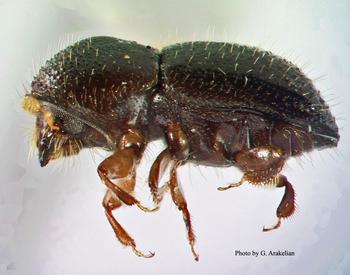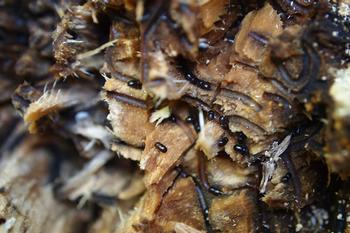Pest Overview
About the Beetles

Female ISHB are ~2 mm (0.08 in) long and range from brown to black in color. Only females can fly and disperse to other trees. Males are smaller (~1.6 mm/0.06 in), range from light brown to black, and have no wings.
Both males and females spend most of their lives inside trees within channels called galleries that the females create by boring into trunks or branches. Once the larvae grow into adults, the beetles will mate inside the galleries, and females will disperse, ready to start their life cycle over again.
Invasive shothole borers do not eat wood. Like other ambrosia beetles, they feed on symbiotic fungi that they “farm” inside trees. These fungi infest the tree tissue, causing a disease called Fusarium dieback.
About the Disease

Known fungal species associated with PSHB are Fusarium euwallaceae, Graphium euwallaceae, and Acremonium pembeum. KSHB carries Fusarium kuroshium and Graphium kuroshium. Although both beetle species appear to be able to feed on the other’s symbiotic fungus, there is no evidence of crossbreeding between beetles.
Fusarium dieback symptoms include pale and wilted leaves and branch dieback. Beetle entry holes are often surrounded by wet discoloration, gumming, or white powdery exudate. Scraping off bark will reveal brown discolored wood surrounding beetle galleries. Learn more about infestation symptoms here.
ISHB-FD Reproductive Hosts in California
ISHB-FD reproductive hosts are plant species that are capable of supporting beetle reproduction and growing the fungi that cause Fusarium dieback. Many more plant species may be attacked by the beetles than those that are currently confirmed to be reproductive hosts. We continuously update the list of ISHB-FD reproductive hosts as new tree species become confirmed.
Origin and History
Experts believe polyphagous shothole borer (PSHB) and Kuroshio shothole borer (KSHB) were introduced to Southern California from Vietnam (PSHB) and Taiwan (KSHB). The beetles presumably arrived via infested wood products or shipping material.
PSHB was first found at Whittier Narrows in Los Angeles County in 2003 but was initially thought to be the tea shot hole borer, a less destructive species within the ISHB species complex. The beetle went unnoticed until 2012 when it was identified as PSHB in a backyard avocado tree. PSHB is now established in Los Angeles, Orange, and Riverside Counties and has also spread to San Bernardino, Ventura, and Santa Barbara Counties. A single beetle was caught in a trap in Santa Cruz County in 2014.
KSHB was first detected in 2014 and confirmed in commercial avocado groves and landscape trees in San Diego County. In 2015, a large-scale infestation was identified in the Tijuana River Valley. KSHB is currently also present in Orange and Santa Barbara Counties. A single beetle was caught in a trap in San Luis Obispo County in 2016.
Current ISHB-FD distribution in California
View a map of identified ISHB-FD infestation areas in California.
Potential Economic Impact
An April 2022 study by Dr. Jetter and collaborators compared the costs and benefits of a monitoring program for early detection of ISHB-FD using Orange and Ventura Counties as case studies. Based on available tree inventory data, they estimated the number and size of very susceptible trees in those counties. The total costs of tree death (includes tree removals, replanting, lost ecosystem services, and lost aesthetic value) varied from $156 million when 10% of trees susceptible to FD are lost over the 10-year time horizon to just over $1.09 billion when 70% of susceptible trees were lost. The costs of the monitoring programs were estimated at either $400,000 or $500,000 per year and the benefits were estimated from the change in percentage killed over 10 years due to the monitoring program. Benefits ranged from $96 million to $935 million depending on the percentage change in the rate of tree death in susceptible trees. When the benefits are compared to the costs, the benefits are always higher than the costs. The rate of return on one dollar invested in monitoring activities returns $24.96 - $40.36 in benefits for the smallest percentage point change when the annual monitoring costs are $500,000 a year. This increases to $149.79 - $242.15 in benefits for every dollar spent on monitoring for the highest percentage point change. In all cases, the benefits of the monitoring program were greater than the costs.
Many efforts have been made in recent years to better understand the economic impacts of invasive species. In their 2017 article, Dr. Gregory McPherson (USDA Forest Service) and collaborators studied the forest structure in urban areas throughout California. They estimated that out of the 70.8 million urban trees present in Southern California, 32.8% (23.2 million trees) are susceptible to the ISHB-FD complex. Should just 50% of these 23.2 million trees at risk die, the approximate cost for removing and replacing the trees with similar species and size would be $15.9 billion. The loss of ecosystem services provided by those trees, including energy conservation, air quality improvement and carbon storage, would generate a cost of $616.8 million annually over the next 10 years.
